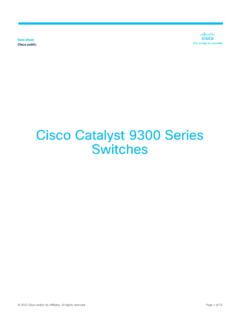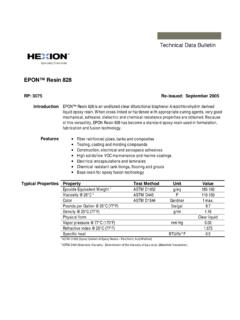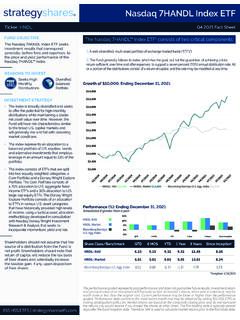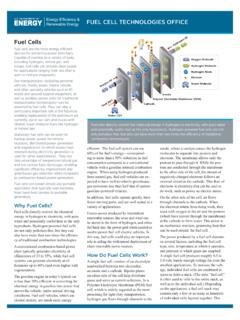Transcription of Oxford Cambridge and RSA AS Level Chemistry A
1 Oxford Cambridge and RSA. AS Level Chemistry A. H032/01 Breadth in Chemistry Friday 26 May 2017 Morning Time allowed: 1 hour 30 minutes * 6 6 9 1 1 0 9 3 0 6 *. You must have: the data sheet for Chemistry A. (sent with general stationery). You may use: a scientific or graphical calculator * H 0 3 2 0 1 *. First name Last name Centre Candidate number number INSTRUCTIONS. Use black ink. HB pencil may be used for graphs and diagrams only. Complete the boxes above with your name, centre number and candidate number. Answer all the questions. Write your answer to each question in the space provided. If additional space is required, you should use the lined page(s) at the end of this booklet. The question number(s) must be clearly shown. Do not write in the barcodes. INFORMATION. The total mark for this paper is 70. The marks for each question are shown in brackets [ ]. This document consists of 24 pages. OCR 2017 [601/5256/4] OCR is an exempt Charity DC (LK/SG) 137333/6 Turn over 2.
2 SECTION A. You should spend a maximum of 25 minutes on this section. Answer all the questions. Write your answer to each question in the box provided. 1 Which ion has a different number of electrons from the other three ions? A Ga3+. B Cl . C S2 . D Ca2+. Your answer [1]. 2 An organic compound has the composition by mass: C, %; H, ; O, What is the empirical formula of the organic compound? A C4H8O2. B C4H10O2. C C 2H 4O. D C 2H 5O. Your answer [1]. 3 Samples of four hydrocarbons are completely burnt under the same conditions of temperature and pressure. Which sample produces the greatest volume of CO2? A mol C2H6. B mol C3H8. C mol C4H10. D mol C5H12. Your answer [1]. OCR 2017. 3. 4 Which reaction produces the smallest atom economy of BaCl2? A BaCl 2 2H2O BaCl2 + 2H2O. B BaO + 2 HCl BaCl2 + H2O. C BaCO3 + 2 HCl BaCl 2 + CO2 + H2O. D Ba + 2 HCl BaCl 2 + H2. Your answer [1]. 5 The burette readings from a titration are shown below.
3 Final reading / cm3 Initial reading / cm3 The burette used has an uncertainty of cm3 in each reading. What is the percentage uncertainty of the resulting titre? A B C D Your answer [1]. 6 Which element has atoms with the greatest number of singly occupied orbitals? A C. B Cl C Ca D Ga Your answer [1]. OCR 2017 Turn over 4. 7 Which compound has polar molecules? A OCl2. B BCl3. C CCl4. D SCl6. Your answer [1]. 8 Which element has the highest melting point? A silicon B phosphorus C sulfur D chlorine Your answer [1]. 9 What is the best explanation for the trend in boiling points down the halogens group? A The covalent bonds become stronger. B The hydrogen bonds become stronger. C The permanent dipole dipole interactions become stronger. D The induced dipole dipole interactions (London forces) increase. Your answer [1]. OCR 2017. 5. 10 Which silver compound is insoluble in concentrated NH3(aq)? A AgNO3. B AgCl C AgBr D AgI.
4 Your answer [1]. 11 cm3 of mol dm 3 NaOH is neutralised by cm3 of mol dm 3 HNO3. The temperature increases by C. The experiment is repeated using: cm3 of mol dm 3 NaOH and cm3 of mol dm 3 HNO3. What is the increase in temperature in the second experiment? A C. B C. C C. D C. Your answer [1]. OCR 2017 Turn over 6. 12 The table shows standard enthalpy changes of combustion, cH. Substance cH / kJ mol 1. C(s) H2(g) C4H10(g) What is the enthalpy change for the following reaction? 4C(s) + 5H2(g) C4H10(g). A kJ mol 1. B kJ mol 1. C + kJ mol 1. D + kJ mol 1. Your answer [1]. 13 The reversible reaction below is allowed to reach equilibrium. H2(g) + I2(g) 2HI(g) H = kJ mol 1. Which change in conditions would be expected to shift the equilibrium position towards the products? A decrease the pressure B decrease the temperature C increase the pressure D increase the temperature Your answer [1]. OCR 2017. 7. 14 What is the systematic name of the compound below?
5 Br A E-2-bromobut-2-ene B Z-2-bromobut-2-ene C E-1,2-dimethyl-1-bromoethene D Z-1,2-dimethyl-1-bromoethene Your answer [1]. 15 The skeletal formula of an organic compound is shown below. O. OH. What is the molecular formula of the organic compound? A C6H10O2. B C6H11O2. C C6H12O2. D C6H13O2. Your answer [1]. OCR 2017 Turn over 8. 16 How many structural isomers have the molecular formula C5H12? A 2. B 3. C 4. D 5. Your answer [1]. 17 Which organic compound has the lowest boiling point? A 2,3,4-trimethylpentane B 2,3-dimethylhexane C 2-methylheptane D octane Your answer [1]. 18 Which alcohol reacts with an acid catalyst to form E and Z stereoisomers? A pentan-3-ol B pentan-1-ol C 2-methylbutan-2-ol D 2,2-dimethylpropan-1-ol Your answer [1]. OCR 2017. 9. 19 An alcohol A is heated under reflux with sulfuric acid and potassium dichromate(VI). The organic compound formed produces the infrared spectrum below.
6 100. transmittance (%). 50. 0. 4000 3000 2000 1500 1000 500. wavenumber / cm 1. Which compound could be alcohol A? A OH. B OH. C. OH. D. HO. Your answer [1]. OCR 2017 Turn over 10. 20 Which alcohol is not likely to have a fragment ion at m / z = 43 in its mass spectrum? A CH3CH2CH(OH)CH3. B CH3CH2CH2CH2OH. C CH3CH(OH)CH2CH2CH3. D (CH3)2 CHCH2OH. Your answer [1]. OCR 2017. 11. BLANK PAGE. PLEASE DO NOT WRITE ON THIS PAGE. OCR 2017 Turn over 12. SECTION B. Answer all the questions. 21 This question is about 2-chloropropene, C3H5Cl. (a) Three reactions of 2-chloropropene are shown in the flowchart below. (i) Complete the flowchart to show the organic products formed in the reactions. Cl H. Br2 H2 / Ni C C. H3C H. 2-chloropropene steam major product [3]. (ii) The reaction of 2-chloropropene with steam requires a catalyst. State a suitable catalyst for this reaction.. [1]. OCR 2017. 13. (b) 2-chloropropene can be polymerised to form poly(2-chloropropene).
7 (i) Write a balanced equation for the formation of this polymer. The equation should include the structure of the repeat unit of the polymer. [2]. (ii) After their useful life, waste polymers can be disposed of by combustion. State one particular problem with disposal of poly(2-chloropropene) by combustion.. [1]. OCR 2017 Turn over 14. 22 This question is about elements from the s-block and p-block of the periodic table. (a) A sample of magnesium is analysed by mass spectrometry. The mass spectrum is shown below. relative abundance (%). 21 22 23 24 25 26 27 28 29. m/z (i) The species causing the peaks in the mass spectrum are 1+ ions of magnesium. Complete the table to show the number of protons, neutrons and electrons in each 1+ ion of magnesium. m/z protons neutrons electrons 24. 25. 26. [2]. (ii) Calculate the relative atomic mass of the magnesium in the sample. Give your answer to two decimal places.
8 Relative atomic mass = .. [2]. OCR 2017. 15. (b) B and C are ionic compounds of two different Group 1 elements. The molar masses of B and C are both approximately 140 g mol 1. A student dissolves B and C in water in separate test tubes and analyses the solutions. The observations are shown below. Observation Test B(aq) C(aq). Addition of HNO3(aq) bubbles no change followed by BaCl2(aq) no change white precipitate Use this information and the observations to identify the formulae of B and C. Explain your reasoning.. [5]. OCR 2017 Turn over 16. (c) Fig. shows first ionisation energies for elements across Period 3. 2500. 2000. 1st ionisation 1500. energy / kJ mol 1 1000. 500. 0. 10 11 12 13 14 15 16 17 18. Atomic number, Z. Fig. (i) Add a point to Fig. for the first ionisation energy of the element with Z = 10. [1]. (ii) Estimate the energy required to form one Na+(g) ion from one Na(g) atom. Give your answer in kJ, in standard form, and to two significant figures.
9 Energy = .. kJ [1]. (iii) Explain why the first ionisation energies in Fig. show a general increase across Period 3 (Na Ar).. [3]. OCR 2017. 17. (iv) Explain why the general increase in first ionisation energies across Period 3 is not followed for Mg (Z = 12) to Al (Z = 13).. [2]. OCR 2017 Turn over 18. 23 Methanol can be prepared industrially by reacting carbon monoxide with hydrogen in the presence of a copper catalyst. This is a reversible reaction. CO(g) + 2H2(g) CH3OH(g). (a) Using the Boltzmann distribution model, explain why the rate of a reaction increases in the presence of a catalyst. You are provided with the axes below, which should be labelled.. [4]. OCR 2017. 19. (b) The reaction for the production of methanol in the presence of the copper catalyst is carried out at 200 300 C. Explain why use of the catalyst reduces energy demand and benefits the environment.. [2]. (c) A chemist investigates the equilibrium that produces methanol: CO(g) + 2H2(g) CH3OH(g).
10 The chemist mixes CO(g) with H2(g) and leaves the mixture to react until equilibrium is reached. The equilibrium mixture is analysed and found to contain the following concentrations. Concentration Substance /mol dm 3. CO(g) H2(g) CH3OH(g) Calculate the numerical value of Kc for this equilibrium. Give your answer to an appropriate number of significant figures. Kc = .. dm2 mol 6 [2]. OCR 2017 Turn over 20. 24 Ethanoic acid, CH3 COOH, is the main dissolved acid in vinegar. (a) Ethanoic acid is a weak acid. What is meant by acid and weak acid? .. [1]. (b) Aluminium is reacted with ethanoic acid. (i) The unbalanced equation for the reaction is shown below. Balance the equation.. Al (s) + . CH3 COOH(aq) . (CH3 COO)3Al (aq) + H2(g). [1]. (ii) This reaction is a redox reaction. Deduce which element has been oxidised and which element has been reduced, and state the changes in oxidation number. Element oxidised.
















